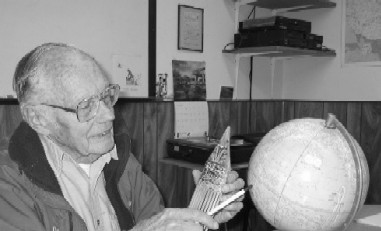
July 21, 2006
One of the routine ways of looking at reports of giant flying creatures from exotic lands is as shown in the new comic, Cryptid, as giant bats (below). But there is another school of thought too.

In Africa, they are called Kongomato (see below – William M. Rebsamen art from Cryptozoology A to Z and a mysterious photograph of one that has surfaced on the internet). In New Guinea, they are named Ropen. Some would have us consider if there are pterosaurs among us still today.

A new book, Searching for Ropens, proposes they do exist.
American cryptozoologist Matt Bille, author of Rumors of Existence and Shadows of Existence, told Cryptomundo, that unless the press release (below) is underselling the new evidence, the one concern Bille has is that Ropen researcher Jonathan Whitcomb "seems to be basing a lot on a few sightings."
Cryptomundo will review the book, if received (Loren Coleman, PO Box 360, Portland, ME 04112), but until then, here’s the latest just released on this new book.
Pterosaur-like Creatures Reported in Papua New Guinea
[Source: Based on a press release from PRWEB]
Intermittent expeditions on Umboi Island, Papua New Guinea, from 1994 through 2004, resulted in the compilation of eyewitness testimonies that substantiated a hypothesis that pterosaurs may not be extinct.
Long Beach, Calif.: July 21, 2006 — The investigation of reports of a pterosaur-like creature in Papua New Guinea has produced some promising findings. According to standard models of science, all pterosaurs became extinct by about 65-million years ago. But due to research of Jonathan Whitcomb, a forensic videographer who interviewed native islanders in 2004, the cryptid the natives call ropen of Umboi Island is at least similar to a long-tailed pterosaur.

He maintains that earlier researchers who explored the island intermittently from 1994 through 2002 were not overly imaginative in believing the creature to be a pterosaur. According to Whitcomb’s new book, Searching for Ropens, there are many similarities between American, Australian, and native eyewitness accounts. Ropens appear featherless with long tails, and reports indicate they eat fish.
Click image for full-size version
Whitcomb, from Long Beach, California, disputes an old idea that they are misidentifications of Flying Fox fruit bats. Two natives described a Ropen holding itself upright on a tree trunk (fruit bats hang upside down from branches), and his book also describes an apparently bioluminescent glow that may help the nocturnal creatures catch fish.
The puzzle for the previous investigators is that they’re unlike Rhamphorhynchoid pterosaur fossils in some ways: A few Ropens are too large and have dorsal ridges along the back. In addition, some eyewitnesses report a head crest on the Ropen while few long-tailed pterosaur fossils have such appendages.

Although Whitcomb admits having no photograph to disprove textbook declarations that all pterosaurs are extinct, he disputes the idea that the Ropen is an unknown bat. His book, Searching for Ropens, examines an investigation by the explorers Garth Guessman, a Southern California firefighter; and David Woetzel, a New Hampshire businessman. Their 2004 expedition, a few weeks after Whitcomb’s, uncovered a native tradition about the Ropen’s tail: It moves only near the tail’s base. This, says Guessman, relates to Rhamphorhynchoid pterosaur anatomy.

Duane Hodgkinson
Before his expedition to Papua New Guinea, Whitcomb questioned Duane Hodgkinson, a flight instructor in Livingston, Montana, who maintains he saw a large “pterodactyl” in 1944, near Finschhafen. The World War II veteran’s description resembles that given by a couple who saw a creature flying over Perth, Australia, in 1997.
Whitcomb also noted in Searching for Ropens similarities to native accounts recorded by earlier explorers on Umboi Island between 1994 and 2002. Whitcomb found no indication of any hallucination or hoax with the two Australians and the American veteran. He also noted that the native eyewitnesses he interviewed mentioned no supernatural elements and that their descriptions resemble those given by the Westerners.
Click image for full-size version
Around Manus Island, the wingspan is three to four feet, according to Jim Blume, a missionary in Wau, on the mainland. Blume’s investigations indicate that wingspans may reach ten to fifteen feet in other areas. Whitcomb’s book mentions a few Ropens that are even larger, including the ones seen by Hodgkinson and the Australian couple.
The book acknowledges differences between the Ropen and Rhamphorhynchoid fossils but it emphasizes that the “diamond” on the Ropen’s tail may relate to the fossil tails.
Whitcomb, a 57-year-old independent videographer who records evidence for attorney firms, completed his book after one year of compiling and analyzing eyewitness testimonies. He encourages a major expedition to videotape a Ropen before the end of 2007.
#####
Thanks to Matt Bille for bringing this release to our attention.

About Loren Coleman
Loren Coleman is one of the world’s leading cryptozoologists, some say “the” leading living cryptozoologist. Certainly, he is acknowledged as the current living American researcher and writer who has most popularized cryptozoology in the late 20th and early 21st centuries.
Starting his fieldwork and investigations in 1960, after traveling and trekking extensively in pursuit of cryptozoological mysteries, Coleman began writing to share his experiences in 1969. An honorary member of Ivan T. Sanderson’s Society for the Investigation of the Unexplained in the 1970s, Coleman has been bestowed with similar honorary memberships of the North Idaho College Cryptozoology Club in 1983, and in subsequent years, that of the British Columbia Scientific Cryptozoology Club, CryptoSafari International, and other international organizations. He was also a Life Member and Benefactor of the International Society of Cryptozoology (now-defunct).
Loren Coleman’s daily blog, as a member of the Cryptomundo Team, served as an ongoing avenue of communication for the ever-growing body of cryptozoo news from 2005 through 2013. He returned as an infrequent contributor beginning Halloween week of 2015.
Coleman is the founder in 2003, and current director of the International Cryptozoology Museum in Portland, Maine.
Filed under Breaking News, CryptoZoo News, Cryptozoologists, Cryptozoology, Evidence, Expedition Reports, Extinct, Eyewitness Accounts, Forensic Science, Living Dinosaurs